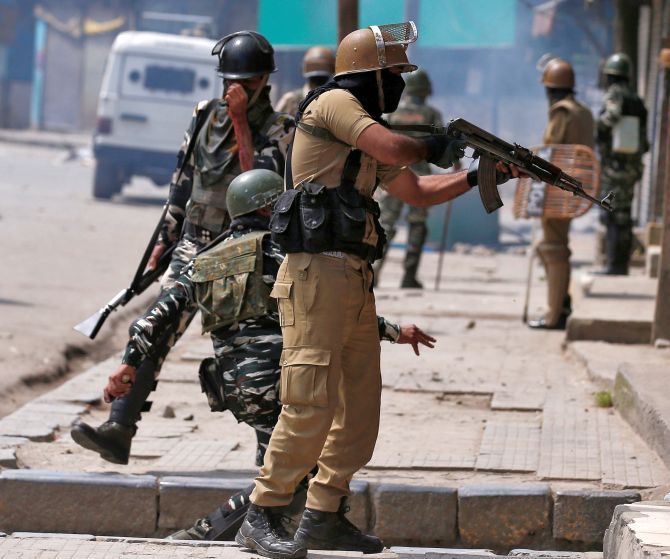It’s been nine years since the dastardly 26/11 terror attacks in Mumbai. More than 150 lives were lost when terrorists entered the country’s financial capital and laid siege to prominent locations, killing hundreds of innocents and scarring thousands of other lives forever.
The Global Terrorism Index 2017 released by the Australia-based Institute for Economics and Peace provides a comprehensive summary of the key global trends and patterns in terrorism over the last 17 years in covering the period from the beginning of 2000 to the end of 2016.
According to the report, this is the second consecutive year, deaths from terrorism declined.
Over the two years there was a decrease of 22 per cent compared to the peak of terror activity in 2014.
Terrorism deaths have fallen significantly in Syria, Pakistan, Afghanistan and Nigeria. However, Islamic State defied this positive trend with over 9,000 deaths, primarily in Iraq and increased activity in OECD countries.
Here's a map explaining how terrorism has affected the world in the past year
The map clearly shows Iraq, Afghanista, Nigeria, Syria, and Pakistan topping the list of countries most affected by terrorism in the past year. India ranks eight on the list.
FIVE MOST IMPACTED COUNTRIES

The above chart shows the top five countries most affected by terrorism in 2017. As one can see, Iraq tops the list with 9,765 fatalities from 2,965 incidents of terror. India, which ranks eighth on the list, had 340 fatalities from 929 incidents.
Here's more on the top five most affected countries.

Levels of terrorism in Iraq were very low prior to the 2003 invasion. The destabilisation of the country led to a steady rise in terrorism and for the last 13 years it has consistently been the country most impacted by terrorism.
In 2016, Iraq experienced its worst year with a 40 per cent increase in deaths. This increase resulted in 2,803 more deaths with a total of 9,765 people killed.

Afghanistan had the second highest number of deaths from terrorism in 2016. However this was 14 per cent lower than the previous year in large part due to reduced terrorist activity by the Taliban. While this reduced number of deaths provides some optimism, it is the second highest number of deaths recorded from terrorism in Afghanistan since the 2002 US invasion.

Nigeria saw the biggest decrease in deaths from terrorism in 2016. Deaths dropped by 63 per cent from 4,940 in 2015 to 1,832. This is a further decline from the peak in 2014 when over 7,500 people were killed. This significant decrease has coincided with successful military actions against various terrorist groups coupled with a decline in domestic support for these groups due to their coercive approaches to recruitment and the pillaging of villages.

A bomb attack on a crowded bus convoy outside Aleppo in Syria claimed the lives of over 126 people on April 15. At least 80 of the fatalities were children. Photograph: Ammar Abdullah/Reuters
Terrorism in Syria is linked to the ongoing civil war which began in 2011. Prior to the conflict, Syria ranked 57 in the GTI and was better placed than the Netherlands. It now ranks fourth. This rapid deterioration highlights the devastating impact of the civil war.

A man mourns the death of a relative who was killed in a suicide blast at the tomb of Sufi saint Syed Usman Marwandi, also known as the Lal Shahbaz Qalandar shrine in Pakistan's Sindh province on February 17. The Islamic State claimed responsibility for the attack. Photograph: Akhtar Soomro/Reuters
For the third consecutive year Pakistan has witnessed fewer terrorist attacks and deaths. In 2016, there were 956 deaths from terrorism; the lowest number in a decade. This is a 12 per cent decrease from the previous year and a 59 per cent decline from the peak in 2013. These improvements are notable as Pakistan has a long history of high levels of terrorism and this year’s result is the best in a decade.

In 2016, India witnessed an increase of 18 per cent in the number of deaths resulting from terrorism when compared to 2015. However, this is still the third lowest number of people killed by terrorism since 2000.
From 2002 to 2015, India has been ranked between second and sixth on the GTI. In the last two years India’s ranking improved to eighth.
When it comes to India, the report states that despite the decrease in deaths over the last two years, the number of terrorist attacks have actually increased. There were 16 per cent more attacks in 2016 than in 2015 in continuing the four year trend of increasing attacks.
Below are the worst attacks in India since 2011 mapped.











